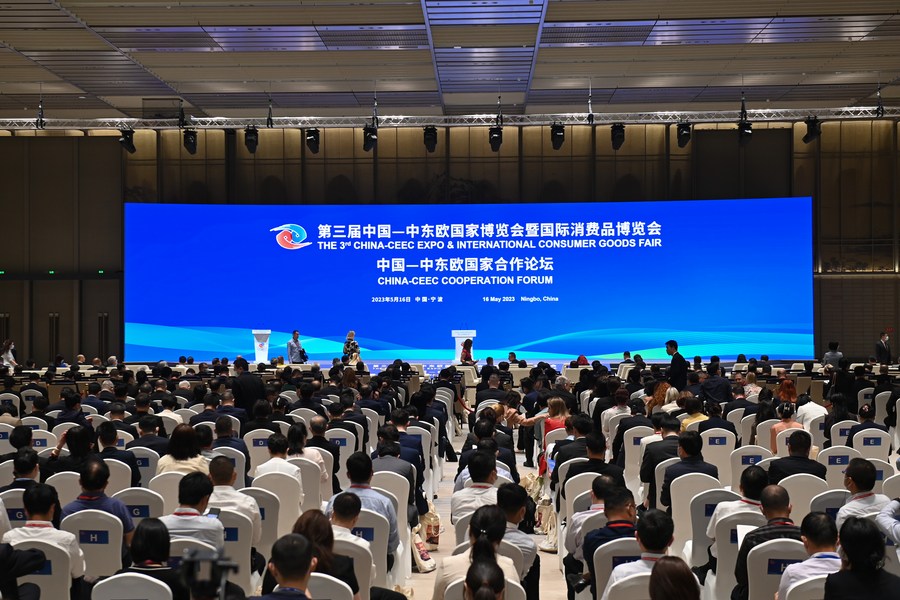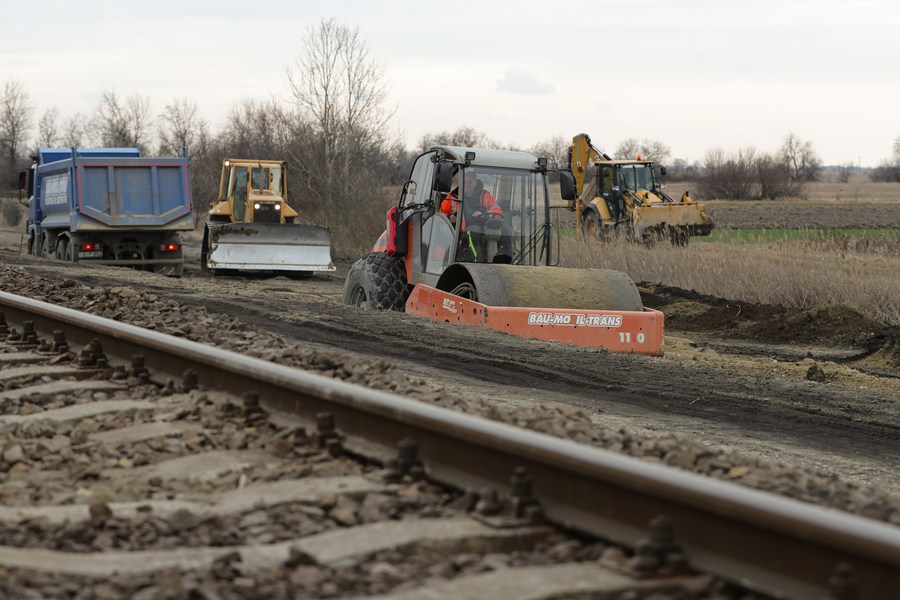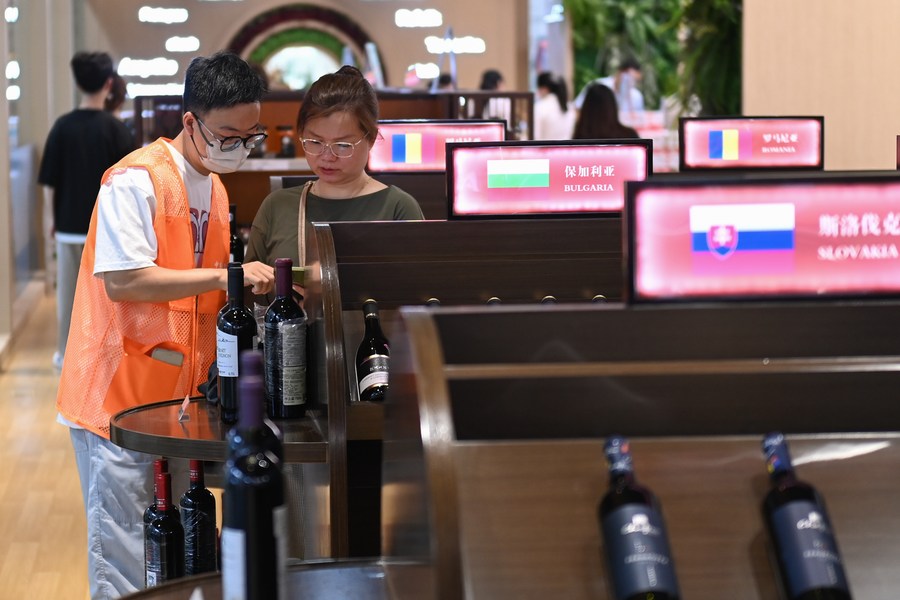Belt and Road Initiative fosters shared growth between China, Central and Eastern Europe

This photo taken on May 16, 2023 shows the opening ceremony of China-Central & Eastern European Countries (CEEC) Expo & International Consumer Goods Fair in Ningbo, east China's Zhejiang Province. (Xinhua/Huang Zongzhi)
Eleven years on, bilateral cooperation has progressed, particularly under the BRI, which has boosted trade, revived growth and sparked new possibilities across the CEECs and beyond through increased connectivity and cooperation.
BEIJING, May 22 (Xinhua) -- China and Central and Eastern European Countries (CEECs) have just concluded a key trade and commerce expo in Ningbo, east China, unleashing new potential for practical cooperation and deeper ties.
This year marks the beginning of the second decade of China-CEEC cooperation. Since 2012, China's trade with CEECs has grown at an average annual rate of 8.1 percent, and China's imports from CEECs have increased at an average rate of 9.2 percent annually. In the first quarter of this year, two-way trade totaled 33.3 billion U.S. dollars, up 1.6 percent yearly.
Eleven years on, bilateral cooperation has progressed, particularly under the Belt and Road Initiative (BRI), which has boosted trade, revived growth and sparked new possibilities across the region and beyond through increased connectivity and cooperation.
PATHWAYS TO PROSPERITY
Commuters, merchants and tourists have been inconvenienced during the border crossing from Bosnia and Herzegovina to south Croatia for decades. A bridge inaugurated in 2022 has made those exhausting trips a thing of the past.

Fireworks are seen during the inauguration ceremony of the Peljesac Bridge in Komarna, Croatia, July 26, 2022. Croatia's Chinese-built Peljesac Bridge opened Tuesday for transport in the village of Komarna, connecting the two parts of the country's coastline for the first time. (Xinhua/Li Xuejun)
A significant BRI and infrastructure project for Croatia, the Peljesac Bridge connects the Croatian mainland with the Peljesac Peninsula of its southernmost Dubrovnik-Neretva County, bypassing a short strip of land belonging to Bosnia and Herzegovina and giving Croatia better access to the area. It also represents a new landmark to further brighten the prospect of China-Croatia and China-Europe relations and cooperation.
Now it takes a breezy three-minute drive to cross the strait for Dubrovnik, a medieval city known as the "Pearl of the Adriatic." What connectivity brings goes beyond tourism. A smoother trade flow means generating thousands of local jobs, something felt by individuals, business people and entrepreneurs.
So far, more than 1.5 million vehicles have used the new bridge, Davor Peric, project manager at Croatian Roads, told Xinhua. "So the basic idea for the bridge, which was obviously long-waited from the local people and the Croatian people altogether, was to connect the territory."
"The Peljesac region, the southern part region that has been disconnected for a long time, has also grown because of the bridge. Economic activity has been increasing recently, and we believe that part of Croatia will definitely develop much faster now that they have completely new roads and the bridge," Peric added.
In Hungary, another flagship BRI project, the Hungarian-Serbian railway connecting the Hungarian capital Budapest and Serbian capital Belgrade, is progressing smoothly. Hungary signed a Belt and Road cooperation document with China in 2015, becoming the first European country to ink such a deal.
Erno Peto, president of the Hungarian-Chinese Chamber of Economy, said that "over the past 10 years, Hungary has become a regional center for finance, tourism and logistics in Central and Eastern Europe of China thanks to the BRI."
Levente Horvath, director of the Eurasia Center of the John von Neumann University in Hungary, said he looks forward to the completion of this project so that Hungarians can benefit from it.

Engineering vehicles are busy at a construction site of Hungary-Serbia railway project in Szabadszallas, Hungary, Feb. 22, 2023. (Xinhua/Zheng Huansong)
Across Serbia, Chinese investments have created thousands of jobs in sectors such as automobile parts, mining, steel, furniture and others, according to the Development Agency of Serbia.
The Belgrade-Novi Sad section of the Belgrade-Budapest high-speed railway launched a year ago "marked a significant turning point in the further development of our Serbia," said Serbian Prime Minister Ana Brnabic.
In Greece, over 13 years of cooperation between China's COSCO Shipping and Greece's largest port Piraeus has proven to be an exemplary case of joint development.
Antonis Apergis, superintendent of the engineering department of Piraeus Container Terminal S.A., said that because of the project, new jobs were created, boosting employment in the surrounding area. "The company has helped the wider region a lot, because if we recall it started in a very difficult period for Greece that we experienced."
"SKY IS THE LIMIT"
"The customer base here in China is huge. I see people are hungry to get the information about high-end, nutritious food, so I see market potential here," Petr Kovanik, owner of a Prague-based chocolate company, told Xinhua at a newly-built venue of the just-concluded China-CEEC expo.
Like Kovanik, many manufacturers, distributors and business insiders are bullish on China's growing sales and investment opportunities, made possible through upgraded logistics under the BRI framework.
"What impressed me most is the ever faster labeling process for imported wines and ever faster shipments of products due to the excellent logistics environment in China," Liakos Constantinos, co-founder of Hellenic Agora Trading Ltd., a Greek wine importer and distributor in China, told Xinhua.
"I am very upbeat about the Chinese market. Alcohol consumption is closely related to economic prosperity. As the Chinese economy continues to grow, so will our business," Constantinos said.
"Our sales in China grew steadily, and export channels expanded despite the pandemic," said Slovakian wine exporter Peter Lisicky, adding that he sees great market potential in China and expects a larger consumer base, probably in central China.

A visitor selects wine at the China-Central & Eastern European Countries (CEEC) Expo in Ningbo, east China's Zhejiang Province, May 16, 2023. (Xinhua/Huang Zongzhi)
Previously, wine transport to Chinese port cities relied on sea freight. However, with the development of the BRI and railways, numerous wine traders are considering expanding their business to other regions within China.
"Bosnia and Herzegovina has broad prospects for cooperation with China and other CEECs in energy, infrastructure, green economic transformation and clean energy. We envision more cooperation projects in the future," said Zdravko Marinkovic, president of the Foreign Trade Chamber of Bosnia and Herzegovina.
According to Yu Yuantang, a Chinese Ministry of Commerce official, China and the CEECs play a crucial role in the global industrial and supply chains as key partners in the BRI. They exhibit high economic complementarity, smooth connectivity, and dynamic two-way investments.
Zahari Zahariev, chairman of Bulgaria National Association for the Belt and Road, underscored the "enormous opportunities" in renewable energy cooperation with China, a leader in the area of photovoltaics, believing that there is potential for further cooperation with China in public goods projects, such as waste disposal, transport and medical care.
Peto, president of the Hungarian-Chinese Chamber of Economy, said China's intention to increase imports from CEECs is critical under the current global economic landscape.
Peto said the CEECs are fully aware that the benefits of the BRI will not be handed to them on a silver platter and that they must work together actively to achieve prosperity.


